The best DJI drones: the top drones from the top drone brand
Struggling to pick the best DJI drone? Here is our guide to which DJI drone does what, and the best deals for each
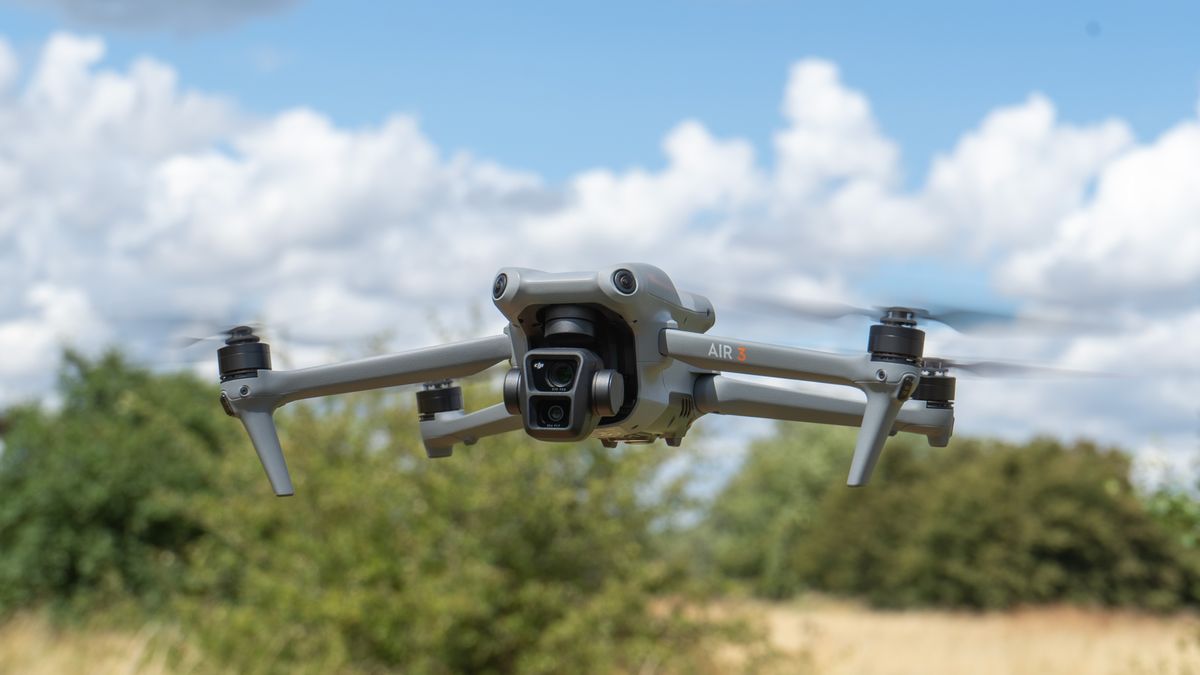
Choosing the best DJI drone deal isn't the easiest decision. As the market leader they have a lot of drones, newer and older, and to some extent, they control the prices, but I've flown them all (and owned many since the very first). I know what's on offer for the cash.
In this definitive list of the best DJI drones, I'll reveal exactly what you'll get for your money, including which of the still available older models might represent a great deal. You won't be surprised that DJI drones also top our list of the best drones around.
From a bit of high-flying fun to the ultimate selfie-drone; from a photographer’s favorite through to industrial and educational quadcopters, DJI has at least one offering in every area. There’s even a drone for crop spraying! 2023 has seen more choices come with the DJI Avata for dramatic yet accessible FPV, a pro-standard Mini drone in the Mini 4 Pro, and the Inspire 3.

Adam has been writing about tech for over two decades and has been building and flying drones – as a hobby and then professionally – for most of that time. He bought his first parts from DJI before the company made its first drone (they sold drone parts!) Adam is our resident expert on all aspects of camera drones and the author of several books including bestsellers The Complete Guide to Drones and The Drone Pilot's Handbook.
If this is your first drone, don't forget that you'll also need to look up the rules wherever you are, especially if you want a drone weighing over 250g / 8.8oz. Without further ado, though, lets's dive in:
Top Picks
Top picks
Why you can trust Digital Camera World
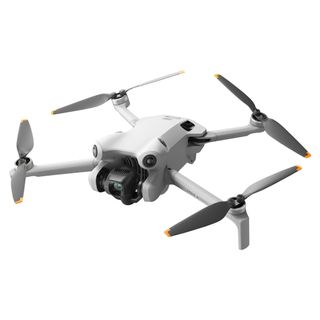
Excellent features for such a compact drone, it might be all you ever need and even serious professionals ought to have one to hand; despite the low weight, this is a high-end drone with all the features many will ever need.
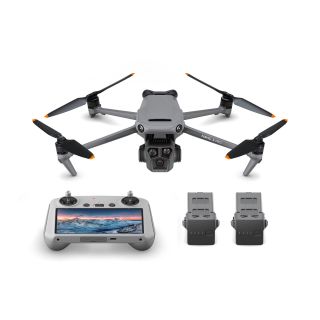
Just wow! The Mavic 3 with as powerful a zoom as is sensible on a drone this size. It's stable and the Cine edition can even shoot ProRes; the addition of a 7x zoom camera means surveys don't mean getting too close either.
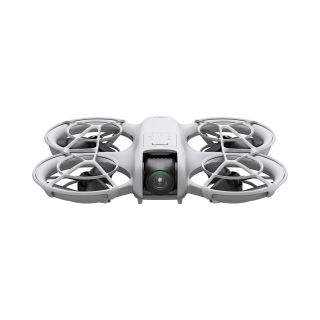
Boasting a 4K camera and a ton of control options (including hand-launch AI-tracking right up to FPV), and a relatively low cost, and really great safety frame, the Neo is a low-cost, high fetured option.
Read more below
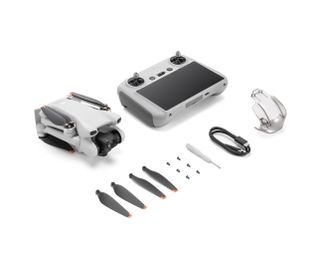
An ultralight drone that everyone can use but which keeps the price under control by leaving out the collision sensors (though it is still easy to land). Excellent 4K camera, just keep an eye out for obstacles and you'll save some cash!
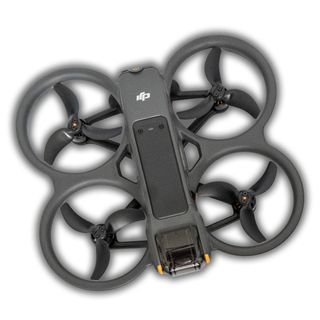
The Avata proved it was possible to build a reasonably safe fast and fun FPV drone which didn't require years of practice to fly thanks to DJI's Motion controller; this latest version refines the tech to near-superlative brilliance. It's a joy to fly.

A fairly small 4K drone with two cameras (1x and 3x) and LiDAR is great in all lights and a good choice for serious imaging without breaking the bank or your back.
The best DJI drones
Best overall
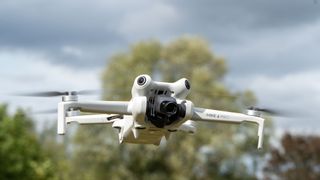
Specifications
Reasons to buy
Reasons to avoid
The DJI Mini 4 Pro builds on the legacy of its predecessor, the DJI Mini 3 Pro, which made waves when it launched in May 2022. The Mini 3 Pro revolutionized the ultra-light drone category, introducing features like collision sensors and a 4K 60fps camera that could rotate to vertical mode—still a rare feature among larger drones. In just under 18 months, the Mini 4 Pro took things even further, adding omnidirectional collision sensors, 10-bit D-Log M video, and waypoint programmable flights, all while maintaining its lightweight design. It can even shoot HDR at a full 60fps, unlike the 30fps limit of the Air 3 Pro.
The Mini 4 Pro is equipped with DJI's updated O4 radio system, offering up to 20km (12 miles) of theoretical range and, more importantly, excellent reception over practical distances. The new DJI RC 2 controller, also seen with the DJI Air 3, provides a premium, professional feel and includes an option with a built-in screen, eliminating the need for a phone and making it more convenient for users.
In some markets (including the USA, but not the UK), there’s also the option to use different batteries, which can push the flight time from the standard 30 minutes to over 40 minutes—though these figures vary based on flying conditions and style. Keep in mind that the drone will register any weight change and may alert authorities.
The Mini 4 Pro’s message is clear: DJI won’t let weight limits hold back creators. However, this comes at a price, which is closer to the company’s higher-end models than other ultra-light drones. For those looking to save, the DJI Mini 3 offers a more affordable option, lacking some of the advanced features like collision sensors but still capturing impressive video and photos for everyday users.
See my full review of the DJI Mini 4 Pro to see sample videos
Best camera
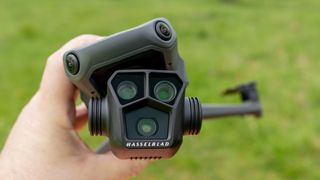
Specifications
Reasons to buy
Reasons to avoid
✅ You want long zooms: The power afforded by the zoom cameras gives a lot of choice, even when you can't get close.
✅ You want all the features DJI offers: This is a flagship, so you'll find all-round collision sensors, subject tracking and mission planning.
❌ You just want the main camera: DJI offers the cheaper Mavic 3 Classic; that still gives you the excellent Hasselblad camera, for a smaller hole in your wallet.
❌ You want zoom but not survey level: A 3x zoom is enough for many creatives to get action – seriously look at the Air 3S as a money-saving alternative.
The DJI Mavic 3 Pro is the top-of-the-line folding drone, and if boasts the kind of specs you'd expect. There are no interchangeable lenses, but DJI has made a high-quality variation of the same principle seen in the iPhone Pro and other flagship phones – a 3-camera system with a main camera with the largest image senor and two others offering up to 7x optical zoom.
The main camera is nominally Hasselblad, too (DJI have a financial stake in the famous brand). It's certainly good enough, and the senor is a spectacular 4/3 system.
At just under 1Kg (and just over 2 pounds) the drone is still very portable, but has enough weight to stand up to tough weather conditions, while the cameras are very impressive indeed.
Creators should note that there is a Cine edition of this camera with the option of ProRes recording to a built-in SSD which increases the cost.
The only word of warning with this device in early 2025 is that there have been one or two rumors of a Mavic 4 Pro model coming in April/May.
See my full DJI Mavic 3 Pro review for sample video
Best value option
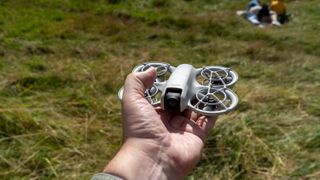
Specifications
Reasons to buy
Reasons to avoid
✅ You want ultimate flexibility: Because you can let this drone control itself, take command with your phone, or get FPV, there is choice (and you don't need to spend all at once).
✅ You want safety: The low weight (well below the limit) and cage design make this drone one of the safest you can get.
❌ You want the best quality: Video is good, but not the best quality available.
❌ You want long flight times: One compromise to keep the weight down is a relatively short battery life (but still better than some hand launch systems).
This drone does a lot of things, despite being the cheapest DJI offer. That amazing flexibility still comes with a 4K camera, though admittedly it has a 1-axis gimbal rather than a 3-axis one, meaning video stabilisation partially depends on AI.
That's not the end of the world though – Electronic Image Stabilization (EIS) and a 1-axis gimbal is also the approach DJI use in their high-end FPV (First Person View) drones like the DJI Avata 2.
Oh, and FPV is one of the things you can do with this nifty little drone. But only one. You can also save yourself a lot of effort by letting it fly itself!
That's right, this drone can be launched from your palm and then will just follow you using the camera and AI. You don't even need a controller
You can also add an app as the controller, or a real radio controller. If you want, you can buy FPV goggles and fly the drone from 'inside'. and DJI offer digital FPV goggles for a surprisingly low cost given the tech involved.
That is a lot of choice, and you don't need to go 'all-in' on day one either. Start with the Neo and add an FPV controller later as your interest expands. An obvious contender for a 'my first drone' (whatever your age)!
Read my full DJI Neo review for more details
Best Cheap 4K
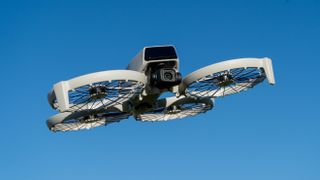
4. DJI Flip
Our expert review:
Specifications
Reasons to buy
Reasons to avoid
✅ You want a 4K ultralight: This might be all the drone you ever need; it can capture 4K video from a 48-megapixel image sensor while staying under the 250g threshold.
✅ You're balancing quality and convinence: It's not too pricey, yet it has safety frames built-in – you can even hand-launch it easily and use AI follow if you like!
❌ You want collision sensors: It doesn't have all-round collision sensors (though it'll hit a tree ten meters up and be just fine – I know, my son has tried!)
❌ You want a true vertical format camera: Unlike the Mini 4 Pro camera, you cannot rotate the camera, only get cropped vertical video.
The lightweight, spoke-based propeller cages might look a bit awkward, but it is a clever, rugged folding design that’s surprisingly compact and portable, bringing all the AI advantages of the Neo and the camera capabilities of other ultralight drones.
Despite the safety design, it doesn't seem to compromise much on flight time, still offering about 30 minutes. While safety features might not be the most thrilling on their own, they make hand-launching a practical option.
DJI has also packed this drone with AI tracking, so you don’t need a remote control for it to follow you—making it a sort of ‘selfie drone.’ However, a remote controller is still included in the box.
You can choose between a controller that requires you to plug in your phone or one with a built-in screen, but either way, DJI ensures you have the option to fly the drone in a more traditional way and fully utilize its camera.
Crucially for creators the drone comes with a 3-axis gimbal that performed well in my tests, even in gusty winds, and includes some nice modern touches, like 2GB of onboard storage in case you forget your memory card. One minor complaint: the enclosed propellers can be a bit louder than other designs, though this is a small tradeoff for the convenience of hand-launching without worrying about your fingers. It’s so user-friendly that even my 8-year-old had no trouble using it, which is probably why DJI markets it as a vlogging drone for everyone.
Read more: DJI Flip review
Features | A camera capable of 4K at 100fps, AI tracking if you choose, and a RAW capable camera. | ★★★★★ |
Design | Some might see it as an ugly ducking, but in this case different is revolutionary, convenient and powerful. | ★★★★★ |
Performance | The camera keeps pace with others from DJI, and my only real reservation was that the frame is (very slightly) less able to cope with gusty wind than | ★★★★☆ |
Value | The DJI Mini 4K offers decent video and RAW images for a lower cost of entry, but this is better and the value proposition is also enhanced by the AI tracking – I admit it's a personal view. | ★★★★★ |
Best for FPV
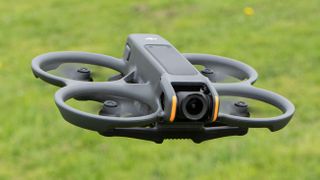
Specifications
Reasons to buy
Reasons to avoid
DJI might dominate the drone world, but FPV has always seemed a little to the side of the company's core camera drones. FPV – First Person View – is taken to mean actually wearing goggles that let you virtually sit inside the drone you're flying and it took time for digital tech to reach the standard it now is (earlier FPV involved interference-ridden analog video).
Now, though, with the Avata 2 the company seems to have got things just right. Having hit upon the "cinewhoop" frame style with the previous generation, the Avata 2 has been all about refinement and this drone is an excellent example of what happens when designers listen to critics. There was a lot right with the Avata, and this is better.
Not only that but the bundled controller – the RC Motion 3 – is also more refined, while DJI's Goggles 3 seems to have reached a much tidier point. Previous generations involved dangling cable batteries, but now this is managed in the forehead grip while at the same time improving ergonomics. Beat that, Apple Vision Pro!
All this comes with the ability to just stop and hover because it's still a DJI drone with GPS – it's like having an emergency brake – so while it might be a bit odd for experienced FPV enthusiasts (who will need to fork out for an optional stick-based controller) if you're coming at FPV just for the fun or to get those into and out of building shots, this will do the job and then some, without requiring years of tiresome practice in full manual mode. The Avata 2 will even do a flip for you!
Read my full DJI Avata 2 review for more details
Best for versatility
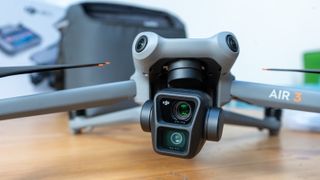
Specifications
Reasons to buy
Reasons to avoid
Since the Air 2S, the drone has put on a little bit of weight and the image sensor is smaller, but by my reckoning it's still the best choice – because now it's got two slightly smaller (but modern, stacked) CMOS image sensors with cameras at a normal (wide) and a medium tele length – much, much better in terms of creativity. It's still lighter – and, importantly, significantly cheaper – than the Mavic 3 Classic (with one camera), let alone the multi-camera Mavic 3 variants.
All the other bells and whistles of the Mavic can be found here – it has version 5 of DJI's AI pilot assist which can track subjects and avoid obstacles and it's as good (i.e. very good, but not quite as cunning as a Skydio). It also gains waypoint mission planning at last.
For anyone wanting a bit more weight and speed – to cope with tougher, windier environments – and the creative clout to capture different kinds of video, this is a fantastic drone. It even has a decent portrait mode that uses the whole height of the sensor. This is a much more video-bias interpretation of the mid-teir brand than the Air 2S, but all the better for it.
• See my full DJI Air 3 review
Best for stills
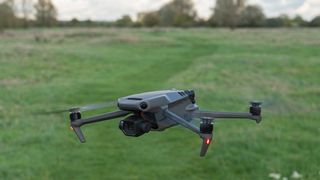
Specifications
Reasons to buy
Reasons to avoid
The Mavic 3 or 3 Pro are powerful drones, and priced accordingly, but not everyone needs a “hybrid zoom.” The Mavic 3 version, especially, is much more about surveying than content creation.
This “Classic” version ditches the relatively low-resolution zoom camera(s) but retains the 4/3 Hasselblad camera on more or less the same airframe (including C1 certification). Video recording with a 10-bit D-log, plus all the low-light benefits of the large sensor, is retained too.
That means creators who would only have used the 24mm EFL camera can pay a little less to get the 15 km range, advanced return to home (avoiding and re-routing around objects), and the excellent battery life of the Mavic 3 without really losing out. In fact, compared to the original’s launch, there are some advantages – the subject tracking, panorama capture, and other functions are all working from day one, and are pretty high-end.
Read our full DJI Mavic 3 Classic review for more details
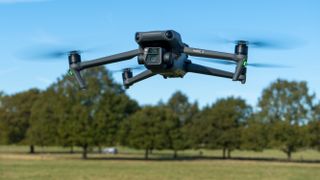
Specifications
Reasons to buy
Reasons to avoid
What makes the standard Mavic 3 such a brilliant device is that, while still being bigger than some telephoto lenses, the entire thing can be stuffed into a kit bag and taken traveling. It doesn’t look noticeably bigger than the older Mavic 2, but it sits more proudly from the ground, helping protect the lenses of the dual-camera gimbal; the system has a large sensor (4/3rds) camera which more than exceeds the old Pro version and bolstered by a 12-megapixel zoom camera for closer views (albeit of less exceptional quality).
The drone has also matured in terms of flight time, hovering for an exceptional 40 minutes (or ploughing forward for 46), and vision sensors (collision avoidance) which use up to 200m “sight” to plot the best return to home route. Sadly not all the software was quite there in time for launch; DJI has promised much in terms of tracking subjects while avoiding, for example, trees, (like a Skydio). This has already improved with one major update, so we’re inclined to trust DJI here, but we won’t know for sure until later in winter 2022 and it wasn’t a great precedent to set in terms of delaying core features.
All that said, in terms of still and D-log video (we’ll cover the Cine edition separately in this list,) this really amounts to a big compact drone.
Read our full DJI Mavic 3 review for more details
Best for cine
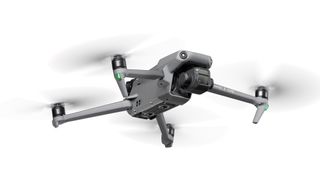
9. DJI Mavic 3 Cine
Specifications
Reasons to buy
Reasons to avoid
We noted at the beginning of the Mavic 3’s mention (above) that its size made it an exceptional device for a 4/3-sensor camera. That compact nature is just as important in the Cine edition which has the same camera but rebuilds the internals to find space for a 1TB SSD and the throughput to handle ProRes 422 HQ video. If you need this format, you’re likely to understand that (and its price), though we did think it a little odd that DJI didn’t even offer the choice of going without the Pro remote, it is one fewer thing to set up.
The new video transmission system, O3+, brings a notable improvement in live view to both Mavic 3s – 60fps rather than 30fps for the 1080P stream which makes on-screen composition greatly more fluid and natural. The drone shares the same faster, more powerful, and more capable airframe too (and the same late firmware features).
Best for pro filmmaking
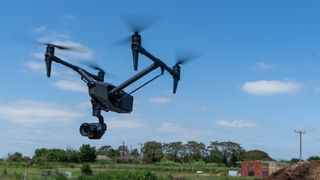
Specifications
Reasons to buy
Reasons to avoid
If the Air 2S is a “creative compact,” this is a high-end DSLR. Like an SLR, there is a choice of lenses, and there is a much bigger full-frame sensor than you will find on other DJI drones.
The large aircraft is powered by two (expensive) batteries and features other backup systems. It can also capture CinemaDNG or Apple ProRes video onto its SSD-based memory card. All of this is aided by 360-degree unobstructed camera rotation, lending itself to dual-operator flights, or fly-bys with automated object tracking.
This is very much a professional aircraft - designed to produce cinema-grade 8K video footage. The big 44-megepixel sensor means that the quality of the image, and most importantly the dynamic range, blows other drones out of the sky. But this is an expensive drone - and significantly more than its predecessor the Inspire 2.
Read our full DJI Inspire 3 review
Retired models
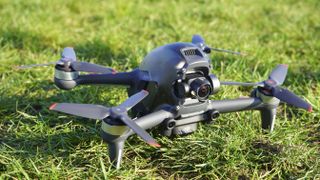
Specifications
Reasons to buy
Reasons to avoid
This is the kind of tech so gorgeous and exciting a Luddite would rethink their life goals at first sight. Apparently eschewing their usual creative goals, DJI has put everything into making this a speedy stunt-capable drone that can more than hold its own in the world of FPV racing; it has a top speed of 140kph and the first 100 of that can be reached in a blinding 2 seconds (for reference, a Formula 1 car takes about 2.6 seconds to accelerate the same amount).
Not forgetting their photography customers (and perhaps understanding that an ordinary racer costs somewhat less), this drone has also been equipped with a much more capable camera system than usually seen on similar drones. The standard practice is to strap a GoPro to the top and recover the footage later, but here a single-axis gimbal (still one more than most FPV racers) has been paired with software to achieve a system capable of capturing excellent 4K video at 60fps, meaning this drone might be for more than just racers.
Read our full DJI FPV Combo review for more details
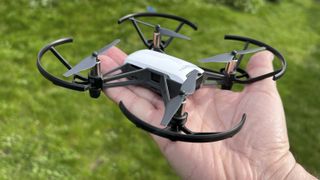
Specifications
Reasons to buy
Reasons to avoid
Found in DJI’s store, but not strictly their line-up (it’s under the Ryze brand), this compact drone nonetheless has much in common with its bigger brothers; it can hold position using downward visual sensors rather than GPS. It can also do stuff a Mavic Mini won’t: perform “8D” Stunts (flips in a number of directions), for example.
The camera is built-in, so impressive software stabilization keeps the 720p video fairly stable; the signal is recorded on your phone (subject to signal errors) rather than an SD card, and there is a selection of social-friendly EZ Shots (a bit like QuickShots on DJI’s pricier drones). This isn’t a photographer’s drone though, it’s for fun – where it excels. It’ll also brighten up learning, with Scratch, a visual programming language, and a complete SDK. Also check out the cool-looking Marvel Iron Man version of this drone, which looks like it has come out of Tony Stark's labs.
The Tello EDU is the same aircraft – with a cool partially transparent shell – but sold with a more sophisticated SDK (software development kit) that offers the chance to do more with the 14-core processor, chief among which is swarm flying. Swift Playgrounds allows control of up to four aircraft at once – be your own wing commander! You’ll also find, in the box, mission pads which the drones can fly over & respond to via the optical flow sensor.
Read our full DJI Ryze Tello review for more details
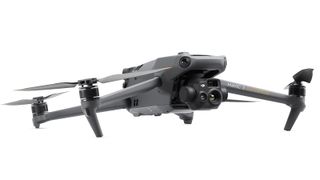
13. DJI Mavic 3 Enterprise (3E and 3T)
Specifications
Reasons to buy
Reasons to avoid
After a long wait, the Mavic 3 has emerged in Enterprise form; the skeleton of the consumer and cine editions made useful for serious business. The 12-megapixel optical zoom sits next to the main camera to provide hybrid zoom inspections, while the mechanical shutter means you don’t need to stop while capturing a crisp image making clean mapping fast. The only real change to the shell is a beacon light at the back and a different camera protector which makes room for the RTK add-on.
The thermal (Mavic 3T) option has a smaller main image sensor but makes room for a 30fps thermal camera with point and area temperature measurement. Pilots can make use of live split-screen at up to 28x zoom for safe distance monitoring. The RC-Pro has a 4x processor power bump too.
Beyond the commercial drone’s long battery life, the Enterprise versions offer a flight interface designed for enterprise in DJI Pilot 2. DJI also has a suite of other applications, including FlightHub 2 for the management of a fleet and DJI Terra for 3D processing and mapping.
FAQs
Why is the weight 250g so important for drones?
In most countries in the world, this is the threshold between 'toy' level and needing to register in some way with your local aviation authority. The tests are usually a quick online exam and a small fee, but it's still nicer to avoid it!
It may also dictate how near you can be to others – 250g is OK in a park, for example, but not a heavier drone.
How we test drones
Our drone tests are carried out in the field, allowing us to assess the quadcopter for its flight performance, easy of use, and its image quality. All our drone reviews are overseen by Adam Juniper who is one of the UK's leading experts in drones, and who has written several books on flying drones, including The Drone Pilot's Handbook.
Read more:
The best drones
The best drones for kids
Best thermal drones
Best drones for travel
The best drone accessories
Best drones for beginners
Best underwater drones
The best indoor drones
Best travel drones
The best camera insurance
Get the Digital Camera World Newsletter
The best camera deals, reviews, product advice, and unmissable photography news, direct to your inbox!

With over 20 years of expertise as a tech journalist, Adam brings a wealth of knowledge across a vast number of product categories, including timelapse cameras, home security cameras, NVR cameras, photography books, webcams, 3D printers and 3D scanners, borescopes, radar detectors… and, above all, drones.
Adam is our resident expert on all aspects of camera drones and drone photography, from buying guides on the best choices for aerial photographers of all ability levels to the latest rules and regulations on piloting drones.
He is the author of a number of books including The Complete Guide to Drones, The Smart Smart Home Handbook, 101 Tips for DSLR Video and The Drone Pilot's Handbook.